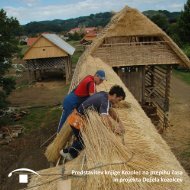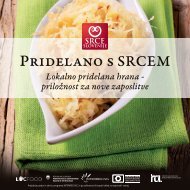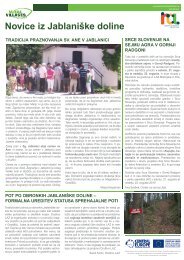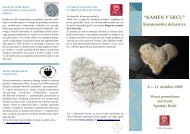Naše kulturno bogastvo - Razvojni center Srca Slovenije
Naše kulturno bogastvo - Razvojni center Srca Slovenije
Naše kulturno bogastvo - Razvojni center Srca Slovenije
- No tags were found...
You also want an ePaper? Increase the reach of your titles
YUMPU automatically turns print PDFs into web optimized ePapers that Google loves.
Shingle makingWooden shingles used for roof-claddingand straw roof-cladding werethe most wide-spread method ofroofing in Slovenia at least until themiddle of the 20th century. Thenits importance began to diminishbecause industrial roofing startedto emerge. Most frequently housesin the higher hilly area were coveredwith cleft shingles or sawn boards;but there are examples of roofs coveredin wood in certain places locatedmuch lower. Today wooden claddingsare most often seen in Carinthia andUpper Carniola, on some church roofsall over Slovenia and on shepherd’scabins and tourist buildings on Velikaplanina.Bojan Koželj has been preserving Alpineshingle making and the roofing-relatedheritage in the area of Kamniška Bistrica.He has been engaged in shingle makingsince 1987 when he officially registered hiscraft. Today he employs three persons andin summer when there is a lot of work hischildren help him. Numerous professionallyreconstructed cultural monumentsthroughout Slovenia are witness to hisprofessional competence, knowledge andskills in wood processing.The procedure of shingle making starts inlate autumn when larch and spruce “resonant”wood is sought in Slovenian forestsin shade areas at the height of above800m. Resonant means that such woodhas a straight and dense grain which isone of the wood quality indicators. Thewood has to be as straight as possibleand without any knots. The selected treesare then felled around December (the socalledold month) when trees no longercontain sap. After the first snow the timberis transported into the valley in such amanner that the wood remains undamaged.The timber is then cut into chunks ofarbitrary length; the chunks are cleft intoapproximately eight parts or krhlji (segments;translator’s note). The centre of theheart is removed because this part of thewood is not good. Then the bark is also removedand the segments are prepared formanual processing - cleaving of shingles.There are several local names known forthe cleft boards: šinkl (Upper carniola) šikl(Styria), šinktl (Carniola), šindra (Inner Carniolaand the area of Kočevje). A shingle isa more literary word. Shingles are aboutup to 14mm thick, their width varies from10 to 17cm. Shingles can be of variouslengths, depending on the wishes of individualclients and most of all on the traditionof roof-cladding in the places wherethe shingles of Koželj are going to go. Thecleft shingles are immediately sheaved bymeans of wires, piled horizontally and adequatelyweighted to be left in the air for atleast a year to dry. Roofs can be clad withshingles from spring to late autumn whenthe roofs are being clad with shingles.Bojan uses two methods of cladding, towit, double layer and triple layer overlapping,which depends on the wishes ofthe clients, i.e. on their financial situation,since wood-cladding is one of the mostexpensive roof-covering methods.Various tools are required for makingshingles: an axe called šinklarca, anotheraxe to eliminate the centre of the timber,various axes for cleaving wood, a cleaverto cleave the segments, a wooden mallet,a cutter, a power saw and a saw calledamerikanka (American; translator’s note).Cleaving shingles is a tiring job whichtakes all day from 6.00a.m. to late in theevening. Koželj makes up to 800 shinglesa day, which means that he could cover20m 2 of roof surface: one square metrerequires as many as 40 shingles. This numberdoubles or even triples if a three-layercladding is applied. Bojan Koželj guaranteesthat his larch shingles can stay on aroof up to 60 years. He knows of cases inwhich some claddings on churches havelasted for one hundred years.The family business is presented at variousfairs in Slovenia but they are planning toplace and present themselves in foreignmarkets. They would like to encourageeven more people for their professionand expand their business. Bojan Koželjis going to organize the presentation ofhis shingles in schools, i.e. make learningpresentations of how shingles are madeas he is well aware of the importance ofthe transfer of knowledge on to youngergenerations.59
















